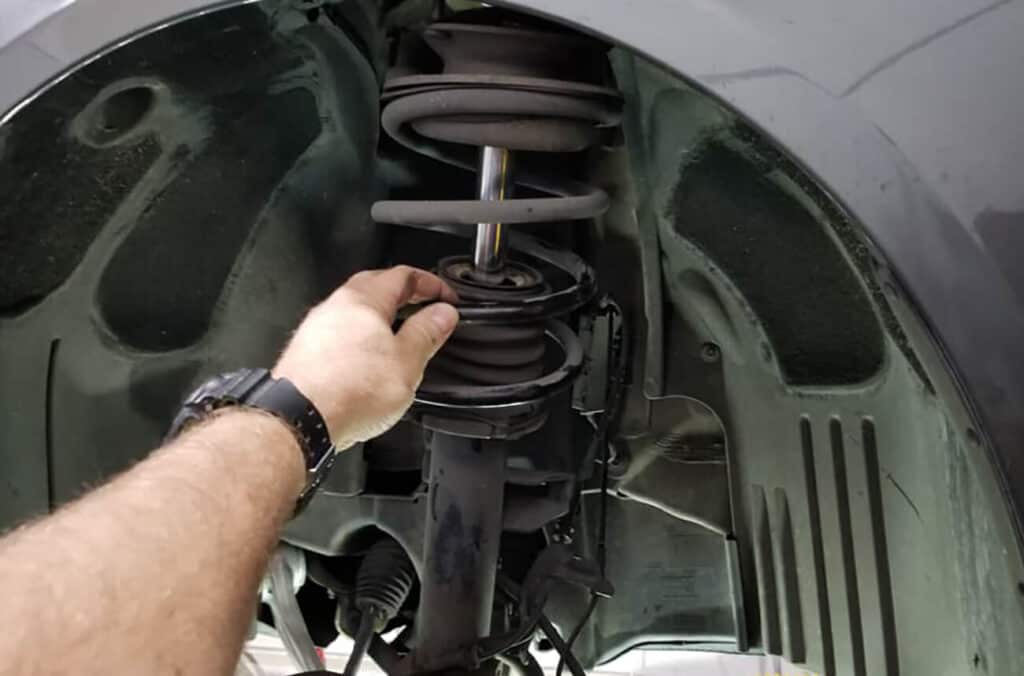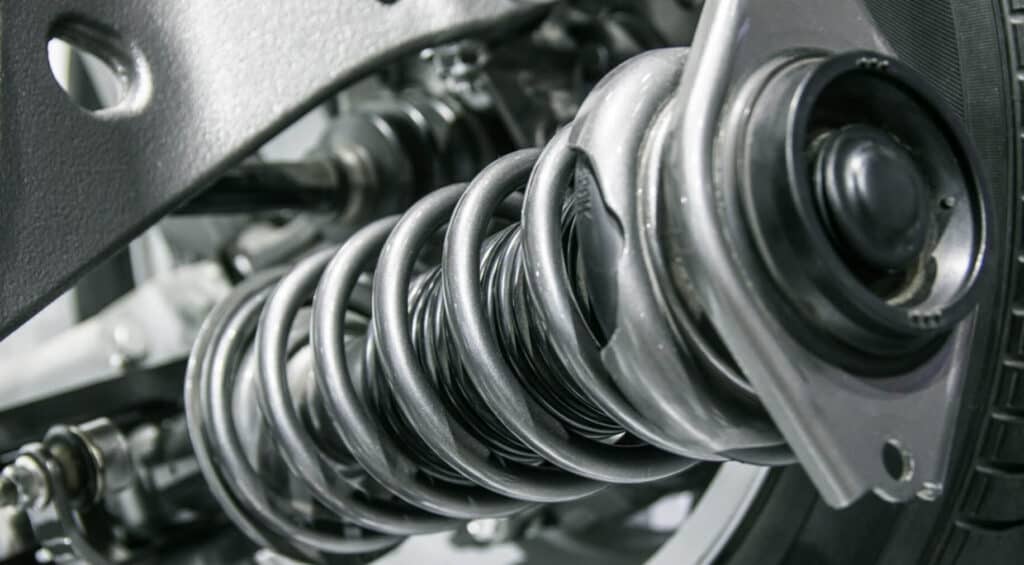A Smooth Ride Isn’t Just Luck — The Science of Longevity in Shock Absorbers and Struts
Ever wondered why some cars seem to glide effortlessly over bumps, while others bounce and jolt? It’s not all about luck or magic; it’s about the science of shock absorbers and struts. These underrated components significantly affect your car’s safety and comfort. Properly maintaining them can save you a hefty sum in the long run. So let’s dive in to find out how you can maximize their lifespan.
Know Your Terrain: The Impact of Driving Conditions on Suspension Systems
The role of your car’s shocks and struts extends beyond smoothing out the bumps; they help you maintain control of your vehicle through various terrains. However, different driving environments pose unique challenges to your car’s suspension system, making it essential to understand the specific wear and tear you can expect.
Driving on city streets can be a gauntlet of potholes, abrupt stops, and speed bumps—all of which place a great deal of stress on your shocks and struts. Each time you hit a pothole, your suspension system has to absorb the impact, and that adds up over time. While you might not be able to dodge every pothole, being aware and slowing down before you hit one can reduce the stress on your suspension system.
Highway driving involves more constant speeds and fewer bumps, but don’t be fooled. The increased speed places a different kind of stress on your shocks and struts. At higher speeds, even minor road irregularities can result in considerable force on your suspension system. Plus, sudden braking and swerving can be even more jarring on a highway. Keeping to the speed limit and maintaining a good distance from the car in front can help mitigate these stresses.
If you’re an adventurer who takes the road less traveled, prepare for a suspension system workout. Off-roading subjects your shocks and struts to extreme forces, from rocky paths to uneven ground and steep inclines. For off-roading, you might consider investing in specialized, heavy-duty shocks and struts that are designed to handle such conditions.

Weather conditions can also be a significant factor. Snow, ice, or heavy rain can make roads slippery, requiring your shocks and struts to work harder to maintain vehicle stability. Salt used on roads in the winter can cause corrosion, affecting the lifespan of metal components of your shocks and struts.
Knowing the terrains you drive on the most can help you tailor your maintenance checks more effectively. For instance, if you mostly drive on city streets, you might opt for more frequent bushing inspections. Or if highway driving is your norm, perhaps more regular alignment checks are in order. Understanding the impact of your driving conditions can better equip you to extend the life of your shocks and struts, ensuring a smoother, safer ride for longer.
Maintenance Checks: Your Suspension System’s Regular Doctor Visits
Think of these as your car’s regular physical exams:
• Consult Your Manual: Always refer to your vehicle’s manual for the manufacturer’s specific recommendations on when to get your shocks and struts checked. The general guideline is around every 50,000 km, but this could vary by make and model.
• Choose a Reliable Mechanic: Select a mechanic experienced in suspension systems for a thorough inspection. A specialist can pick up issues that general mechanics may overlook.
Key Inspection Points
– Bushings: These act like cushions between the metal parts and absorb shocks. Check for wear and tear.
– Mounting Hardware: Ensure all screws, bolts, and other hardware are tightly in place.
– Fluid Leaks: Leakage of hydraulic fluid is a sign of damaged shocks or struts.
• Alignment Check: Misalignment can strain your shocks and struts. Ensure your wheels are properly aligned.
• Check for Rust or Corrosion: Especially critical for those living in areas with heavy snowfall and road salts.
• Preventive Replacement: If your mechanic suggests your shocks and struts are nearing the end of their service life, consider replacing them early to avoid failure at a critical moment.
Regular maintenance checks can catch problems early, sparing you from unexpected failures and more expensive fixes down the line.
The Role of Quality Parts: Why Skimping Now Costs More Later
When it comes to replacing or maintaining the shocks and struts in your car, you might be tempted to go the budget-friendly route with generic parts. While that choice might save you a few dollars in the short term, it can end up costing you more in the long run. Here’s why.
Higher-quality, brand-name shocks and struts are usually made from superior materials and undergo rigorous testing to meet industry standards. These components are designed to last longer and are often backed by more extended warranties. The long-lasting nature of these parts means fewer replacements over the life of your car, ultimately saving you money.
Quality shocks and struts don’t just last longer; they also perform better. These parts can handle more significant stresses and are generally more efficient at dampening bumps and vibrations. This translates into better road-handling characteristics, offering a safer, more comfortable ride. If the part you’re installing is crucial to your vehicle’s safety, it’s hardly the place to cut corners.
Skimping on quality can lead to more frequent part failures and, consequently, more trips to the mechanic. Each replacement comes with its own labor costs, making the overall price of frequent, lower-quality replacements higher than investing in a quality part initially.
Driving Habits: Small Changes for Big Impact
Believe it or not, how you drive day-to-day can significantly impact the life of your shocks and struts.
• Speed Bumps: Always slow down well before reaching a speed bump; don’t brake directly on it. This minimizes the force exerted on your shocks and struts.
• Cornering: Try to avoid sharp turns at high speeds. This puts less strain on your suspension system.
• Potholes: Make a conscious effort to avoid potholes and uneven surfaces when possible, as these can quickly degrade your shocks and struts.
• Load Limit: Don’t overload your vehicle; excess weight can damage the suspension system over time.
• Smooth Braking: Avoid hard braking as much as possible. Sudden stops can jolt your shocks and struts, causing quicker wear and tear.
• Regular Tire Checks: Well-maintained tires help distribute weight and stress evenly, taking some of the load off your shocks and struts.
Cultivating good driving habits may not seem like a big deal, but when it comes to the longevity of your shocks and struts, it makes a world of difference.
DIY Measures: Simple Inspections and Adjustments You Can Do at Home
Sometimes you don’t need to visit the doctor for a check-up; a little self-care can go a long way. These DIY checks, while not a substitute for professional inspections, can be helpful between those more comprehensive check-ups:
1. Visual Inspection: At least once a month, give your shocks and struts a visual once-over.
a. Check for fluid leaks
b. Look for rust or corrosion
c. Examine rubber bushings for wear or splitting
2. The Bounce Test: With the car parked, press down firmly on the front hood and then release. If the car bounces back more than two or three times, your shocks or struts may need attention.
3. Listen for Noises: Pay attention to any strange sounds when driving, especially over uneven terrain. Sounds like rattling or thudding could indicate a problem with your shocks or struts.
4. Check Tire Wear: Uneven tire wear can be a sign that your shocks and struts are not functioning properly, redistributing the weight unevenly on your tires.
5. Basic Cleaning: If accessible, clean your shocks and struts using a simple cloth to remove dirt and grime, which can contribute to quicker wear and tear.
6. Consult the Owner’s Manual: Many modern cars have guidelines for basic at-home checks for suspension systems. Following these could catch early signs of trouble.

When to Invest in Upgrades: Performance Shocks and Struts
Let’s say you’re more than just a nine-to-fiver on the road. Perhaps you’re an enthusiast who enjoys spirited driving, or maybe off-roading is more your style for weekend fun. In these situations, it may be wise to consider upgrading to performance shocks and struts.
Performance shocks and struts are built to handle extreme conditions much better than their standard counterparts. Whether it’s taking tight corners at high speeds or navigating rocky trails, performance parts offer superior durability and responsiveness. They are built using high-quality materials and often feature advanced engineering that gives them an edge in harsh driving conditions.
While they may cost more upfront, the investment can be well worth it for an improved driving experience. Performance shocks and struts offer enhanced road grip and steering response, making your ride not only more secure but also more enjoyable.
Certainly, performance shocks and struts come at a premium. However, when you factor in their durability, the less frequent need for replacements, and the enhanced safety and driving experience they offer, it’s easy to see why they can be a worthy investment. Moreover, if your driving habits are more intense than average, these upgrades are not a luxury but a necessity for long-term vehicle health.
Taking the Long Road — A Recap of Lifespan Maximization Tips
Being an informed vehicle owner isn’t just about knowing when to fill up the gas tank; it’s about understanding how to keep your car running smoothly for years to come. Maximizing the lifespan of your shocks and struts is a crucial part of that knowledge. By following the tips outlined in this article, you’re setting yourself up for a safer, smoother, and more cost-effective ride.
Call to Action
Ready to take control of your car’s health? Booking a mobile mechanic for your next shock and strut check-up is easier than ever with Uchanics. Convenient, professional, and committed to quality, Uchanics makes your vehicle’s longevity a top priority. Book your appointment today and hit the road with newfound peace of mind.
